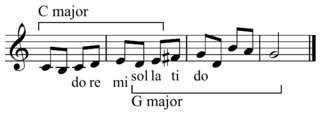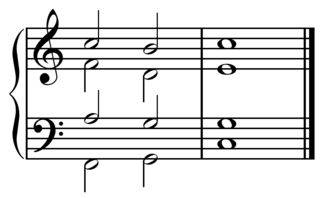In music theory, the term mode or modus is used in a number of distinct senses, depending on context.

In music, harmony is the process by which individual sounds are joined together or composed into whole units or compositions. Often, the term harmony refers to simultaneously occurring frequencies, pitches, or chords. However, harmony is generally understood to involve both vertical harmony (chords) and horizontal harmony (melody).
In music, the tonic is the first scale degree of the diatonic scale and the tonal center or final resolution tone that is commonly used in the final cadence in tonal classical music, popular music, and traditional music. In the movable do solfège system, the tonic note is sung as do. More generally, the tonic is the note upon which all other notes of a piece are hierarchically referenced. Scales are named after their tonics: for instance, the tonic of the C major scale is the note C.
In music theory, the key of a piece is the group of pitches, or scale, that forms the basis of a musical composition in Western classical music, art music, and pop music.
Tonality or key: Music which uses the notes of a particular scale is said to be "in the key of" that scale or in the tonality of that scale.
An octatonic scale is any eight-note musical scale. However, the term most often refers to the symmetric scale composed of alternating whole and half steps, as shown at right. In classical theory, this symmetrical scale is commonly called the octatonic scale, although there are a total of 42 enharmonically non-equivalent, transpositionally non-equivalent eight-note sets.

A chord, in music, is any harmonic set of pitches/frequencies consisting of multiple notes that are heard as if sounding simultaneously. For many practical and theoretical purposes, arpeggios and other types of broken chords, may also be considered as chords in the right musical context.

In music, modulation is the change from one tonality to another. This may or may not be accompanied by a change in key signature. Modulations articulate or create the structure or form of many pieces, as well as add interest. Treatment of a chord as the tonic for less than a phrase is considered tonicization.
Modulation is the essential part of the art. Without it there is little music, for a piece derives its true beauty not from the large number of fixed modes which it embraces but rather from the subtle fabric of its modulation.

In music, relative keys are the major and minor scales that have the same key signatures, meaning that they share all the same notes but are arranged in a different order of whole steps and half steps. A pair of major and minor scales sharing the same key signature are said to be in a relative relationship. The relative minor of a particular major key, or the relative major of a minor key, is the key which has the same key signature but a different tonic.

Tonality is the arrangement of pitches and/or chords of a musical work in a hierarchy of perceived relations, stabilities, attractions and directionality. In this hierarchy, the single pitch or triadic chord with the greatest stability is called the tonic. The root of the tonic chord forms the name given to the key, so in the key of C major, the note C can be both the tonic of the scale and the root of the tonic chord. The tonic can be a different note in the same scale, when the work is said to be in one of the modes of the scale.
In Western musical theory, a cadence is the end of a phrase in which the melody or harmony creates a sense of full or partial resolution, especially in music of the 16th century onwards. A harmonic cadence is a progression of two or more chords that concludes a phrase, section, or piece of music. A rhythmic cadence is a characteristic rhythmic pattern that indicates the end of a phrase. A cadence can be labeled "weak" or "strong" depending on the impression of finality it gives. While cadences are usually classified by specific chord or melodic progressions, the use of such progressions does not necessarily constitute a cadence—there must be a sense of closure, as at the end of a phrase. Harmonic rhythm plays an important part in determining where a cadence occurs.
The term sixth chord refers to two different kinds of chord, the first in classical music and the second in modern popular music.
The modern Lydian mode is a seven-tone musical scale formed from a rising pattern of pitches comprising three whole tones, a semitone, two more whole tones, and a final semitone.

In music, a closely related key is one sharing many common tones with an original key, as opposed to a distantly related key. In music harmony, there are six of them: five share all, or all except one, pitches with a key with which it is being compared, and is adjacent to it on the circle of fifths and its relative major or minor, and one shares the same tonic.
A modal frame in music is "a number of types permeating and unifying African, European, and American song" and melody. It may also be called a melodic mode. "Mode" and "frame" are used interchangeably in this context without reference to scalar or rhythmic modes. Melodic modes define and generate melodies that are not determined by harmony, but purely by melody. A note frame, is a melodic mode that is atonic, or has an unstable tonic.
The ragtime progression is a chord progression characterized by a chain of secondary dominants following the circle of fifths, named for its popularity in the ragtime genre, despite being much older. Also typical of parlour music, its use originated in classical music and later spread to American folk music. Growing, "by a process of gradual accretion. First the dominant chord acquired its own dominant...This then acquired its dominant, which in turn acquired yet another dominant, giving":

The passamezzo antico is a ground bass or chord progression that was popular during the Italian Renaissance and known throughout Europe in the 16th century. The progression is a variant of the double tonic: its major mode variant is known as the passamezzo moderno.

A double tonic is a chord progression, melodic motion, or shift of level consisting of a, "regular back-and-forth motion," in melody similar to Bruno Nettl's pendulum type though it uses small intervals, most often a whole tone though may be almost a semitone to a minor third.

A level, also "tonality level", Gerhard Kubik's "tonal step," "tonal block," and John Blacking's "root progression," is an important melodic and harmonic progression where melodic material shifts between a whole tone above and a whole tone below the tonal center. This shift can occur to both neighboring notes, in either direction, and from any point of departure. The steps above and below the tonic are often called contrasting steps. A new harmonic segment is created which then changes the tonality but not necessarily the key.

In music, the dominant 7♯9 chord is a chord built by combining a dominant seventh, which includes a major third above the root, with an augmented second, which is the same pitch, albeit given a different note name, as the minor third degree above the root. This chord is used in many forms of contemporary popular music, including jazz, funk, R&B, rock and pop. As a dominant chord in diatonic harmony, it most commonly functions as a turnaround chord, returning to the tonic.

Parallel and counter parallel chords are terms derived from the German to denote what is more often called in English the "relative", and possibly the "counter relative" chords. In Hugo Riemann's theory, and in German theory more generally, these chords share the function of the chord to which they link: subdominant parallel, dominant parallel, and tonic parallel. Riemann defines the relation in terms of the movement of one single note:
The substitution of the major sixth for the perfect fifth above in the major triad and below in the minor triad results in the parallel of a given triad. In C major thence arises an apparent A minor triad, D minor triad (Sp), and E minor triad (Dp).

 Play (help·info).
Play (help·info).
 Play (help·info)
Play (help·info)








